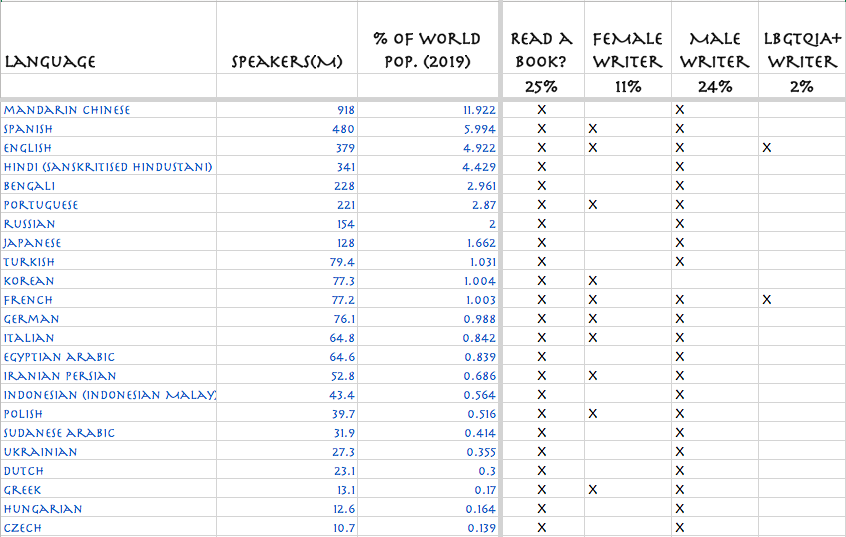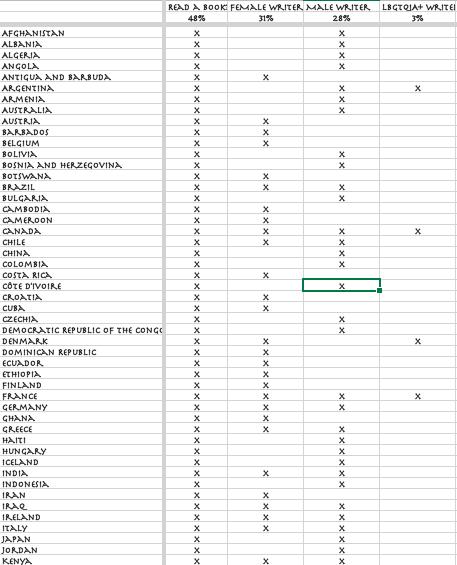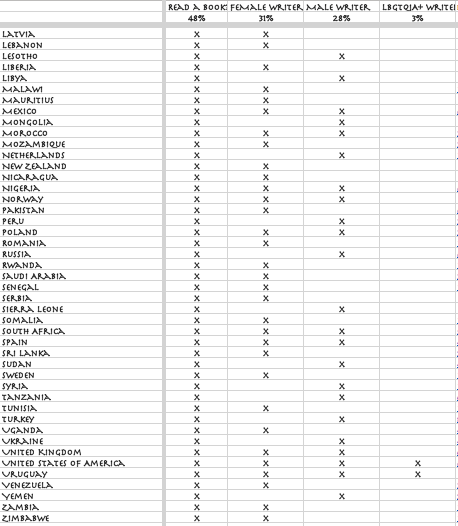It’s time to review my reading for the last year and see how I did with respect to my goals of reading widely outside of the Western White Male Canon (WWMC). While reviewing some publishing statistics, I realized that the WWMC was the main focus of my education in the U.S. and that the focus continued unconsciously even in my self-directed reading due to publishing and societal norms. If you want to read wide, you have to be proactive and search those books out.
My goal is to see if I can read authors from as many genders and orientations, from as many cultures and communities, from as many languages and experiences as possible. My hope is that by the time this reading life is over, my stats will more adequately represent the diversity of writers creating literature in the world. I’m more interested in cultures and communities and peoples than I am countries, as I resist Nationalism in general and especially in these fraught days of politicized Nationalism. But countries are useful for categorization and cataloging, obviously, so I use them as one metric. When I pulled data, there were 195 countries and 91 languages with over 10M first-language speakers. So that’s part of my baseline. But it’s a fluid goal hoping to shine a wider lens on the human experience.
As I’ve written in my previous posts (here and here) about women writers, this reading diversity is an especially tough goal in the private press world. One can only try to find the books that are out there and encourage presses to widen their focus while still being able to keep the lights on and the presses running. But since this is a blog on private press books, I’ll start there: of the 62 books I read in 2019, only 5, or 8%, of them were private press books. Four of them were reviewed here: Moon as Bright as Water, the Tao te Ching, Pedro Páramo and Pride and Prejudice. The fifth was Larkspur Press’ edition of The Great Interruption by Wendell Berry. So two books from the Chinese, one from the Spanish, and two in English; four male and one woman writer. Pretty good under the circumstances. Reviews for this blog will probably migrate back towards the WWMC long term simply because that is mostly what is left unread or unreviewed in my library or what I can get my hands on. I’ll continue to try buy/borrow books outside the canon when I run across them.
At this point, I’ll switch to my overall reading for those interested, and first I’ll tackle languages. It’s going to get pretty left-brained, book-nerdy from this point on so if you’re only interested in fine press you might want to bail. I pulled down information on worldwide languages and have a list of the 91 languages that have over 10M first language speakers. Of those languages, I’ve read books in translation from 25% of them over the last few years. In addition, I’ve read books translated to English from 15 languages that have under 10M first-language speakers. The breakdown of male, female, and LGBTQIA+ writers in the top 91 languages is shown in Table 1 and for the 15 additional languages in Table 2.


Looking at the data from the perspective of the 195 recognized countries in the world, I’ve read books from 48% of them (Tables 3A and 3B). In keeping with my mission to normalize my reading outside of books written by men, I’m happy to see that I’ve read women writers from more countries than men.


The previous data is historical throughout my reading life but is weighted heavily to the last few years where I’ve made a concerted effort to read more widely. Now I’ll switch the focus to the 62 books I read in 2019.
In 2019 my reading was split dead even between women and men writers, which, of course, jives with population metrics. So that’s perfect. Where I made the most progress is the fact that only 25% of my reading was in the WWMC, so that even of the half of my reading that was written by men, a full half of that reading were by male authors who were People of Color or Indigenous (POCI). 10% of the books were by authors that were LGBTQIA+. Indigenous writers are way underrepresented in the publishing world but I managed to read three of them, accounting for 3% of my reading. Again, good progress in all those metrics.
I’m very happy that of the 62 books I read, 33 of them were literature in translation. The breakdown of languages is shown in Chart 1. The most read foreign language in 2019 was French with 10 books (represented by the multicolor pie slice), followed by Chinese with 5 books, and the rest around the chart clockwise.

Of the 30 books I read that were written in English, only 17 of them were by English as 1st language writers; the other 13 were written in English by writers whose first language was something else. That breakdown is shown in Chart 2, with English as 1st language writers the multicolor slice followed by the other languages already documented in Chart 1 (Note: the colors shift between the charts) and ending with English as 2nd language (ESL) writers.

French, Chinese, and Norwegian are the top three languages read primarily because I am in the middle of three big works: Proust’s six book In Search of Lost Time, the five-volume translation by David Tod Roy of Lanling Xiaoxiao Sheng’s Chin P’ing Mei (The Plum in the Golden Vase), and Karl Ove Knausgaard’s My Struggle, of which I read the first four books, two volumes, and four books, respectively. For my analysis, I counted each of those books separately even though I refer to the work they belong to in some cases.
It is too hard for a book lover like me to pick a favorite, especially from among sixty-two books that are so varied in their subjects, styles, and perspectives. But I will hazard a few that I would recommend and that may even merit a re-read if my if my reading-life is long enough.
Since I am already on a re-read of Proust, it’s probably safe to say that In Search of Lost Time is one of the all-time favorite works of literature I’ve read. I’ve already read Swann’s Way a couple of times (once for this review) and the whole work once through in the Scott-Moncrief translation. My re-read is in the new translations edited by Christopher Prendergast and I’m up to the fifth volume, The Prisoner and the Fugitive.
My favorite new book was Ducks, Newburyport. This book was just so creative and fun and relevant to read, especially if you live in the U.S. The fact is is that Lucy Ellmann is an amazing writer. I’ll probably want to re-read this one and only wish there was a hardback edition. If you do tackle this book and want some support and help, I really liked the Two Month Review podcast discussion of Ellmann’s work. I would also highly recommend, in no particular order, The Old Drift by Namwali Serpell, Tram 83 by Fiston Mwanza Mujila, Until the Lions: Echoes form the Mahabharata by Karthika Nair, Bone People by Keri Hulme, Moon of the Crusted Snow by Waubgeshig Rice, and Cantoras by Carolina De Robertis.
My favorite 2020 private press book would have to be Pedro Páramo for its combination of being the best “read” of the five I read, a classic of world fiction, its illustrations, and the fact that its publishing was a dream come true for me. On the other hand, if I had to choose a “desert island” book, it would be the Tao Te Ching because that one would best help me survive or resign myself to my fate…And if I could choose one of my top recommendations that could realistically be tackled by a private press, I would pick Until the Lions. I just can’t see a private press doing the Ellmann (especially given the fact that we’re still waiting for Finnegans Wake, which it resembles in punctuation if not in other ways). And Nair’s book is based on one of the classic epics of world literature and might lend itself to be partitioned into multiple volumes that could be handled by smaller presses not able to tackle the whole thing at once.
For the upcoming year, I’m looking forward to possibly finishing the Proust, Sheng, and Knausgaard works, although I only have the latter physically on my shelves at this point. I’m also looking forward to some “read-wide firsts”: my first Georgian novel, The Eight Life by Nino Haratischvili, my first novel by a Tatar author, Guzel Yakhina’s Zuleikha, and my first novel by a Turkish woman author, Every Fire You Tend by Sema Kaygusuz. And, of course, adding whatever genders, languages, countries, and cultures I can find over the next year. For this blog, I hope to get to fine/private press editions of a WWMC classic, a European woman writer of an African novel, and a classic of African American literature. I’ll leave you to guess what those might be as I’m never sure what’s up next, especially as one of them is not yet on my shelf.
And for those interested, here is the complete list of books read in 2019:
Naja Marie Aidt, When Death Takes Something from You Give It Back: Carl’s Book
Alaa Al Aswany, The Automobile Club of Egypt
Ayesha Harruna Attah, The Hundred Wells of Salaga
Jane Austen, Pride & Prejudice
Honoré de Balzac, Pere Goriot; The Marriage Contract, The Muse of the Department; A Prince of Bohemia; A Man of Business; The Girl with Golden Eyes; Sarrasine
Ishmael Beah, A Long Way Gone: Memoirs of a Boy Soldier
Wendell Berry, The Great Interruption
Marie-Claire Blais, Literary Affair
Upile Chisala, soft magic
Ani DiFranco, No Walls and the Recurring Dream: A Memoir
Lucy Ellmann, Ducks, Newburyport
Roxane Gay, Difficult Women
Laura Jane Grace, Tranny: Confessions of Punk Rock’s Most Infamous Anarchist Sellout
Qin Guan, Moon as Bright as Water
Abdulrazak Gurnah, Gravel Heart
Mä Harel, Hortari: Forgotten Explorers and Seekers
Keri Hulme, The Bone People
Sarah Husain, Voices of Resistance: Muslim Women on War, Faith and Sexuality
Christos Ikonomou, Good Will Come From the Sea
Ida Jessen, A Change of Time
Karl Ove Knausgaard, My Struggle: Book One, Book Two: A Man in Love, Book Three, Book Four
Niviaq Korneliussen, Last Night in Nuuk
Fernanda Laguna, Sueños y pesadillas
Ursula K. Le Guin, Lao Tzu: Tao Te Ching: A Book about the Way and the Power of the Way
Fritz Leiber, Swords Against Death
Sarah J. Maas, Throne of Glass
Imbolo Mbue, Behold The Dreamers
Stephen Mitchell, Lao-tzu’s Tao te ching
Erika Moen, Oh Joy Sex Toy, Volume 1
Michael Moorcock, Elric of Melniboné, The Fortress of the Pearl
Fiston Mwanza Mujila, Tram 83
Abdelrahman Munif, The Trench, Variations on Night and Day
Karthika Nair, Until the Lions: Echoes from the Mahabharata
Jóanes Nielsen, The Brahmadells
Yewande Omotoso, The Woman Next Door
Patanjali’s Yoga Sutras
Marcel Proust, Swann’s Way, In the Shadow of Young Girls in Flower, The Guermantes Way, & Sodom and Gomorrah
Riikka Pulkkinen, True
Zahia Rahmani, France, Story of a Childhood
Waubgeshig Rice, Moon of the Crusted Snow
Carolina De Robertis, Cantoras
J. K. Rowling, Harry Potter and the Goblet of Fire, Harry Potter and the Order of the Phoenix
Juan Rulfo, Pedro Páramo
Elisabeth Rynell, To Mervas
Amina Said, Present Tense of the World: Poems of Amina Said 2000-2009
Namwali Serpell, The Old Drift
Lanling Xiaoxiao Sheng, The Plum in the Golden Vase, or, Chin P’ing Mei, Volume 2: The Rivals, Volume 3: The Aphrodisiac
William Shakespeare, Macbeth
Ana Teresa Torres, Doña Inés vs. Oblivion
Harriet E. Wilson, Our Nig: Or, Sketches From the Life of a Free Black Serhiy Zhadan, Mesopotamia

I love this.
Interested to see so many titles from Honoré de Balzac. I read “Pere Goriot” this year and loved it. My first Balzac novel. Any suggestion on what of his I should read next?
Well, I have a long and emotional attachment to Balzac unrelated to his literary merit: I was given a complete set of his by one of my grandmothers that I loved (both the grandma and the books) but that were later “disappeared” by my ex- when we separated. Last year I walked into a closing bookstore on their last day of business, knowing they had a set I couldn’t afford (several hundred $$) but not knowing they were going out of business. The shelves were pretty bare and it was $10/grocery bag of books. Apparently 39 volumes of Balzac was too much for anyone before me, so I managed to stuff it in 3 bags for $30. Since I try not to buy books I’m not planning to read, I’ve been applying myself to them now that Balzac is back in the house.
The set is a 1909 edition that combines multiple titles in each volume, so when I read one I chose, I feel like I have to read the others in that book too. That’s why there are so many titles. I think my favorites so far are Pere Goriot, The Girl With the Golden Eyes, and The Muse of the Department. I think I’m going to tackle Lost Illusions next, as I’m curious about some things I’ve heard about Vautrin. I also want to read Scenes from a Courtesan’s Life, which was referred to in my reading of Proust, and which might have been too racy to include in my 1909 set. At least I haven’t been able to find it in there.
To all those who number reading as a major avocation this post is fascinating. Just a couple of points. Wuthering Heights did not appeal to John Carey (The Unexpected Professor, 2014) either. He called it “tiresome”. For me, it is amongst my all-time favourite books. I re-read it (the ultimate test) in a really nice limited edition copy produced by The Fraser Press in 1970. It had lost none of its strange power after fifty years. So, tastes really do differ.
Jane Austen is in a league of her own really. I find her humour and her satire very winning. The last thing I read was Sanditon which is hilarious. A re-reading of Mansfield Park was most rewarding recently.
I have about 100 metres of shelving in my flat and have run out of room so purchases are strictly of books I want to read now! Storage of books in my garage with a de-humidifier to protect them from damp is a necessary measure but not a desirable one. My plans to move are a work in progress. Main aim – more space for books and for visitors. I am sad to read the suggestion that not all your volumes came through a change of circumstances safely. Good luck with finding replacements as needed.
Thanks for a fascinating post.
Thanks for your kind words! I had a look at that Fraser Press Wuthering Heights and that is a nice edition. There’s even a full leather copy available for $125. Seems like a great value. I’d be tempted to snatch that up if I loved the book like you do!
Yes, the green full leather edition is the one I have. In 1970 and 1971 The Fraser Press produced seven titles in limited editions each available in leather of with paper boards. They appear each to have been in a different format rather than a uniform format. The leather copies often have very badly sunned spines. David Copperfield might interest you if you could find a pristine leather-bound copy. If I re-read David Copperfield, this is the one I’d go for.